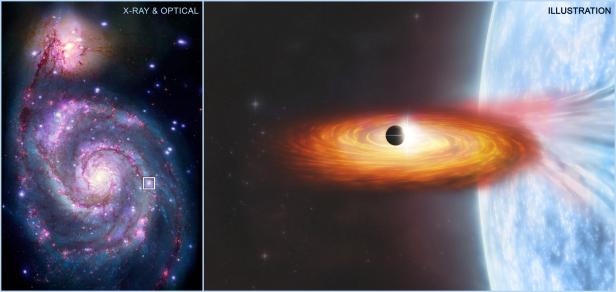Researchers at Harvard and Smithsonian University in Cambridge were able to make an exciting discovery NASA reports. You may have discovered the first planet in another galaxy – it’s calledouter planets“.
as outer planets One refers to planets outside our solar system. Exoplanets outside our galaxy. All exoplanets found so far are in our galaxy Milky Way. almost all Closer than 3000 light years to ground.
Exoplanet discovered now on the verge 28 million light years Removal. Researchers suspect it is in the galaxy Messier 51 (M51). A spiral galaxy is also called vortex galaxy It is known for its distinctive shape.
Transit method to find planets
Exoplanets are usually found in which the light of their stars is with Transit Method under investigation. If an exoplanet wanders in its orbit between its star and Earth, the star’s light becomes slightly darker. If this happens regularly, one can assume that it is an exoplanet in the orbit of a star. This method works reliably only when the stars are close enough. The farther away the stars are, the smaller the measurable fluctuations in the visible spectrum of light become.
Although the researchers’ new method is also based on the transit method, they do not examine optical light, but rather X ray. They specifically looked at binary star systems with bright X-rays.
Binary systems with incandescent x-rays
These systems usually include one Neutron star or black holeIt sucks gas from a companion star in orbit. Matter near the neutron star or black hole heats up and glows in X-rays.
This glow is very bright, but it is very small in regional terms. The planet passing in front of it covers almost all of the X-ray radiation. So instead of looking for minimal fluctuations, one can look for binary systems in which the X-ray radiation disappears completely at regular intervals.
On the left, the Whirlpool galaxy marked M51-ULS-1. Explanation on the right. The exoplanet wanders in front of the neutron star or black hole, which pulls gas from the companion star.
© NASA
An extraterrestrial planet as big as Saturn
In this way, the binary system becomes M51-ULS-1 Explore them in the Whirlpool Galaxy. An X-ray space telescope was used for this purpose Chandra used. Within 3 hours of observation, the measured X-rays had decreased from 0.
From the data it was calculated that the discovered planet was roughly the same size as the planet Saturn he is. It should be twice as far from a neutron star or black hole as Saturn is from the Sun. its name: M51-ULS-1b.
However, it would be difficult to confirm M51-ULS-1b as an exoplanet. According to the researchers, it could take decades before crossing over is noticed again. Since you don’t know how long it takes a planet to orbit a neutron star or black hole, you don’t know exactly when to look to see a transit again.
The planet has already survived a supernova
If M51-ULS-1b is in fact a planet, it has already passed a lot. It has survived at least one supernova that gave rise to the neutron star or black hole. In addition, the second star in the system is supposed to explode at some point, exposing the planet to high levels of radiation again.
To find M51-ULS-1b, researchers examined 55 star systems in M51, 64 in Messier 101, and 119 in Messier 104. So far there has been only one discovery. With Chandra and XMM-Newton, galaxies much closer than M51 are now being examined. This would make it possible to observe shorter transits and increase the chance of observing multiple transits of exoplanets.
The researchers’ study was first published in September 2020. It is published today in Nature Astronomy.

“Problem solver. Proud twitter specialist. Travel aficionado. Introvert. Coffee trailblazer. Professional zombie ninja. Extreme gamer.”



More Stories
With a surprise in the case: a strange cell phone from Nokia was introduced
PlayStation Stars: what it is, how it works and what it offers to its users | Sony | video games | tdex | revtli | the answers
t3n – Digital Pioneers | digital business magazine